Pro wrestling likes to take the burning social issues of the day, amplify them, then reflect them back at us, using the wrestlers to portray our own feelings, fears, and hang-ups. Wrestling plays on our emotions, offending us and pressing our buttons as the wrestlers tip-toe (or stomp) across the lines of decency. It can also remind us how badly we’re behaving, mocking and mimicking our boorish actions, to teach us all a lesson.
In this race war from Portland in the early 1980’s, “Playboy” Buddy Rose gets some cheap Heel heat by portraying a racist bully with a rude mouth. After belittling the beloved Rocky Johnson (the Rock’s father), Rose assaults the man, whipping him and bloodying his face, forcing him to wear the dreaded “crimson mask,” a mark of shame in pro wrestling. The hearts of the fans also bleed for the oppressed victim (partly because he looks so darn good in a pair of trunks) and causes everyone in the audience to regret times when they may have acted rude or racist or prejudiced.
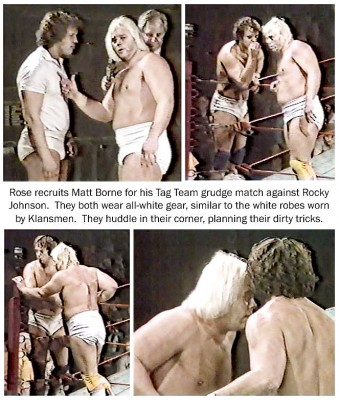 Before you get all offended by this bigot and his racist actions, just remember those were different days. People weren’t as sensitive about racial taunts back then, and society was still working out what was off limits. Heel wrestlers back then were expected to be as crude and offensive as they could be, to really draw the heat and hatred of the crowd.
Before you get all offended by this bigot and his racist actions, just remember those were different days. People weren’t as sensitive about racial taunts back then, and society was still working out what was off limits. Heel wrestlers back then were expected to be as crude and offensive as they could be, to really draw the heat and hatred of the crowd.
Both Rose and Johnson decide to go find a partner (of the same race), dress up in matching outfits with him, and settle their burning hatred in a Tag Team match.
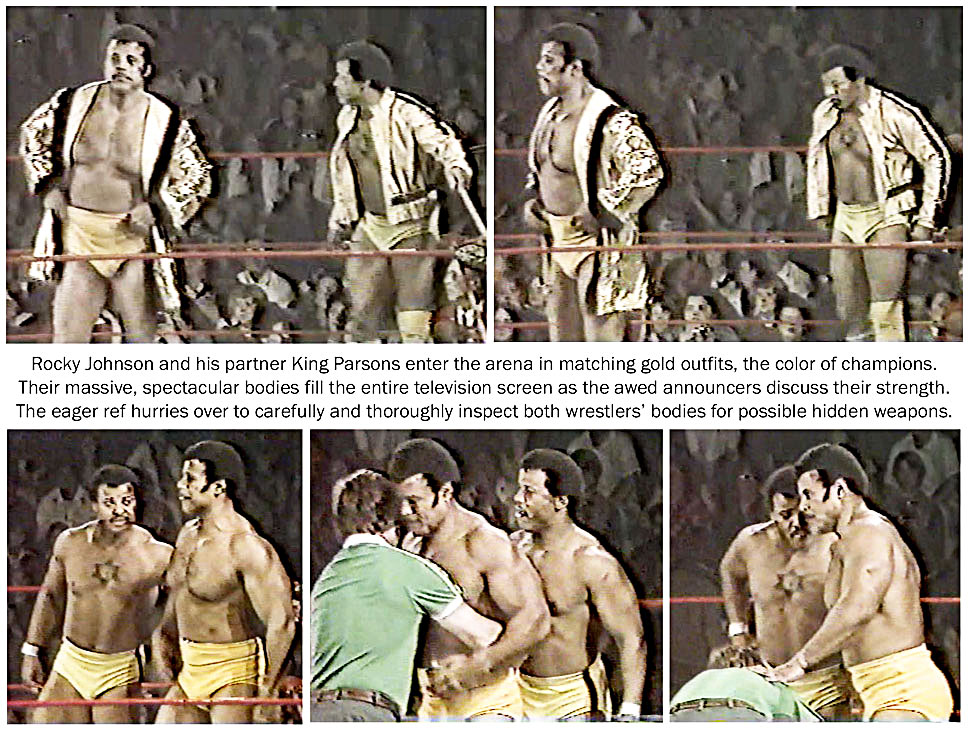
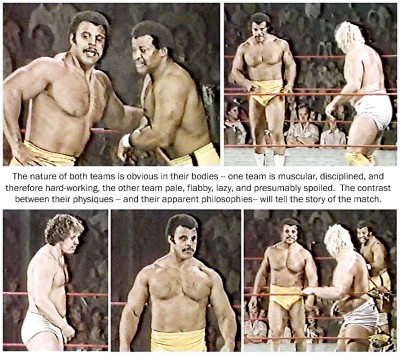 The African American team are the obvious heroes, their thick torsos exploding out of their yellow trunks and shiny gold ring jackets. They are the picture of power, and their bulging trunks add to their hyper-manliness and sex appeal. Rose and Borne on the other hand are pale and flaccid in comparison. Their matching white trunks are not a symbol of honesty, but of arrogance, privilege, and cowardice.
The African American team are the obvious heroes, their thick torsos exploding out of their yellow trunks and shiny gold ring jackets. They are the picture of power, and their bulging trunks add to their hyper-manliness and sex appeal. Rose and Borne on the other hand are pale and flaccid in comparison. Their matching white trunks are not a symbol of honesty, but of arrogance, privilege, and cowardice.
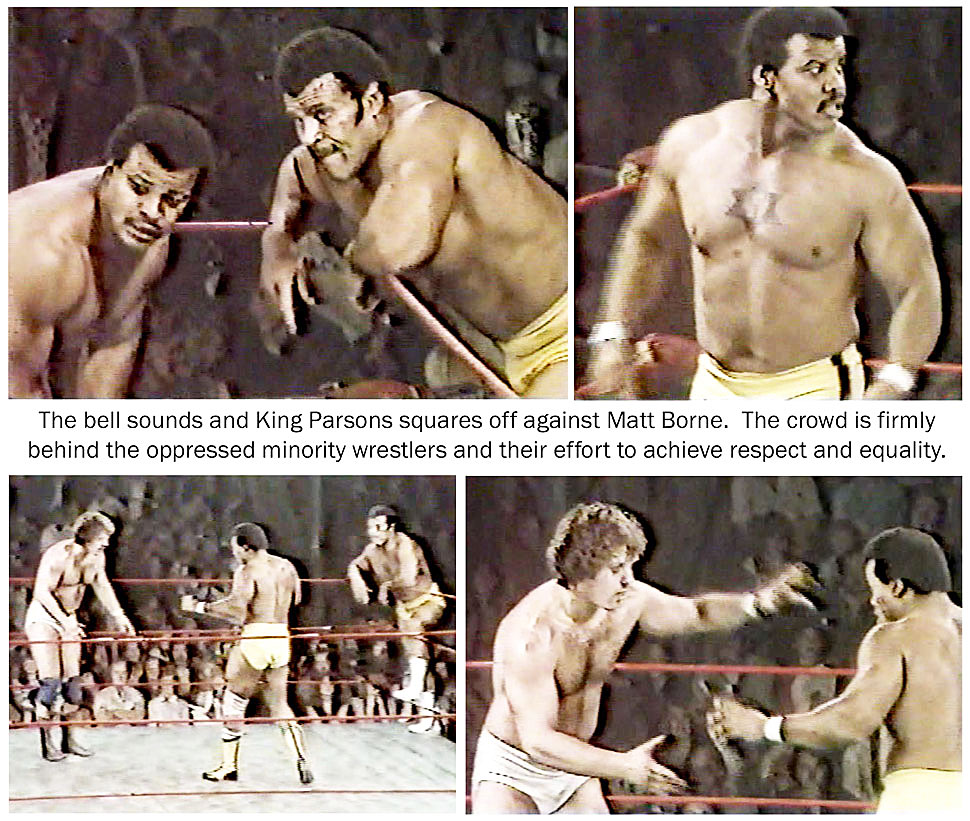
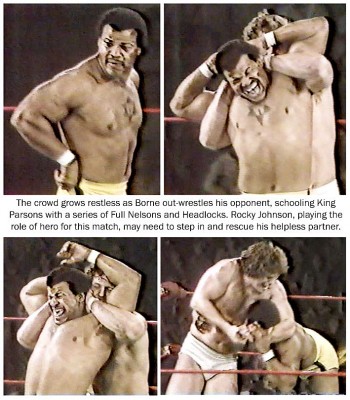 The crowd is certainly eager to see justice served — to see the down-trodden victims put the bullies in their place and secure a victory.
The crowd is certainly eager to see justice served — to see the down-trodden victims put the bullies in their place and secure a victory.
But pro wrestling doesn’t always give the fans what they want. Instead, pro wrestling portrays the world as it exists: an unfair, biased place where cheaters often prosper. I think we can agree that, during the 1980’s, racism was around. The fact that pro wrestling hit us with the Race Card in this match proves that many people were noticing and thinking about the color of the athletes and their social positions at the time.
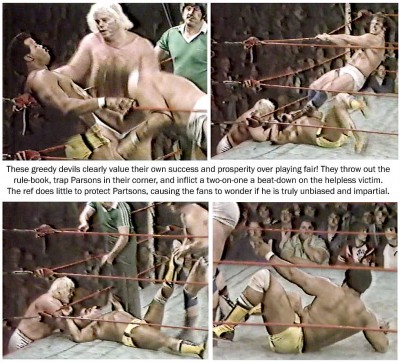 What unfolds in the ring is a disgusting display of cruelty and unfair tactics by the team in white against their minority opponents. They repeatedly break the law and the ref looks the other way (but if the black team use similar tactics, they have the rule-book thrown at them.) The imagery of the two fat white men stomping and crushing their lone black victim under their boots is meant to trigger outrage and sympathy from the audience.
What unfolds in the ring is a disgusting display of cruelty and unfair tactics by the team in white against their minority opponents. They repeatedly break the law and the ref looks the other way (but if the black team use similar tactics, they have the rule-book thrown at them.) The imagery of the two fat white men stomping and crushing their lone black victim under their boots is meant to trigger outrage and sympathy from the audience.
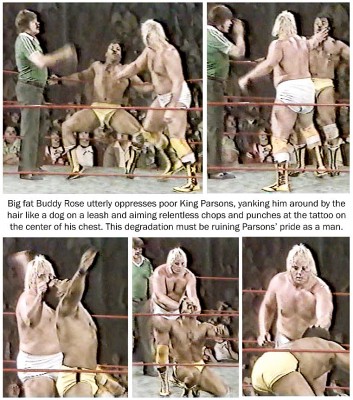 But you also have to wonder how many in the audience maintained certain racist attitudes and were enjoying this humiliation and punishment. If a white man were worried about losing his job, his wife, or his position in society, might he actually prefer (deep down in his heart) seeing these superior, powerful African American gods being whooped into submission? Might this match really be intended not to cause outrage over the cruel treatment of the minority team, but to reassure members of the majority that their positions of privilege could still be secured by hook or by crook?
But you also have to wonder how many in the audience maintained certain racist attitudes and were enjoying this humiliation and punishment. If a white man were worried about losing his job, his wife, or his position in society, might he actually prefer (deep down in his heart) seeing these superior, powerful African American gods being whooped into submission? Might this match really be intended not to cause outrage over the cruel treatment of the minority team, but to reassure members of the majority that their positions of privilege could still be secured by hook or by crook?
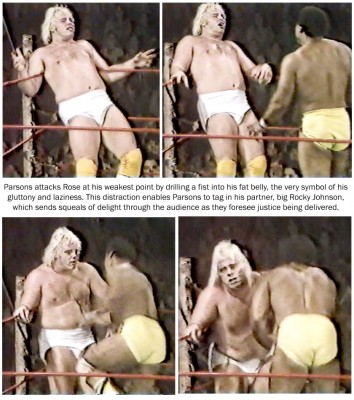 “Playboy” Buddy Rose was really the perfect villain in the role of cowardly oppressor and bigot. He was overweight and unattractive (especially compared to his He-Men opponents here) but he bleached his hair and repeatedly told everyone he was a desirable “Playboy.” He tried to sell us on the idea that being blond and white (and presumably rich) was all he needed to be attractive. Also, he looked gluttonous and pale with that big soft belly, as if he had never worked hard in his life. He was the image of a lazy, rich complainer who cries out for more, but hasn’t earned it.
“Playboy” Buddy Rose was really the perfect villain in the role of cowardly oppressor and bigot. He was overweight and unattractive (especially compared to his He-Men opponents here) but he bleached his hair and repeatedly told everyone he was a desirable “Playboy.” He tried to sell us on the idea that being blond and white (and presumably rich) was all he needed to be attractive. Also, he looked gluttonous and pale with that big soft belly, as if he had never worked hard in his life. He was the image of a lazy, rich complainer who cries out for more, but hasn’t earned it.
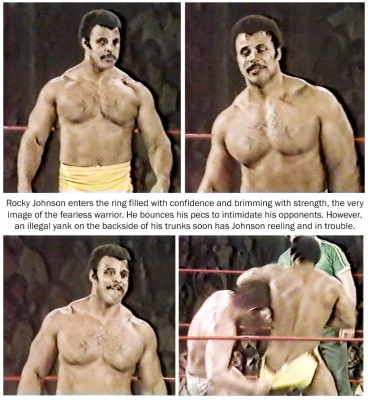 Rocky Johnson represents the opposite spectrum. He is clearly a disciplined man based on that jaw-dropping physique. He has a sense of humor, he’s respectful, plays fair, and tries to get ahead through hard work. Certainly the working men in the audience can relate to him (or would like to think they have a lot in common). The hallmark of a great Baby-Face wrestler is being able to earn the respect and sympathy of the fans just by the way you walk to the ring, and Johnson had that down to a science.
Rocky Johnson represents the opposite spectrum. He is clearly a disciplined man based on that jaw-dropping physique. He has a sense of humor, he’s respectful, plays fair, and tries to get ahead through hard work. Certainly the working men in the audience can relate to him (or would like to think they have a lot in common). The hallmark of a great Baby-Face wrestler is being able to earn the respect and sympathy of the fans just by the way you walk to the ring, and Johnson had that down to a science.
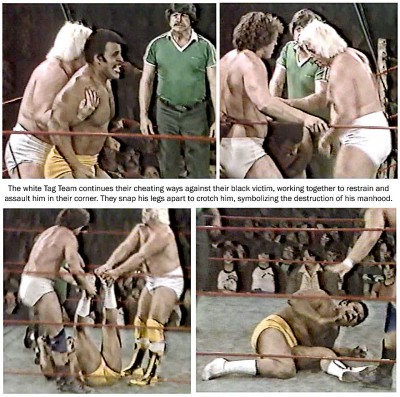 Rocky Johnson’s real name was “Wayde Bowles,” so where did he come up with the name “Rocky Johnson?” The obvious reference is the name “Johnson” being a slang term for the male organ. “Rocky” may describe extreme hardness or possibly a back and forth motion. I suppose one way to get over with the fans is to make them think about sex every time they say your name. In any case, the villains in this match deliberately destroy his rocky johnson to subdue the big stud and put him in his place.
Rocky Johnson’s real name was “Wayde Bowles,” so where did he come up with the name “Rocky Johnson?” The obvious reference is the name “Johnson” being a slang term for the male organ. “Rocky” may describe extreme hardness or possibly a back and forth motion. I suppose one way to get over with the fans is to make them think about sex every time they say your name. In any case, the villains in this match deliberately destroy his rocky johnson to subdue the big stud and put him in his place.

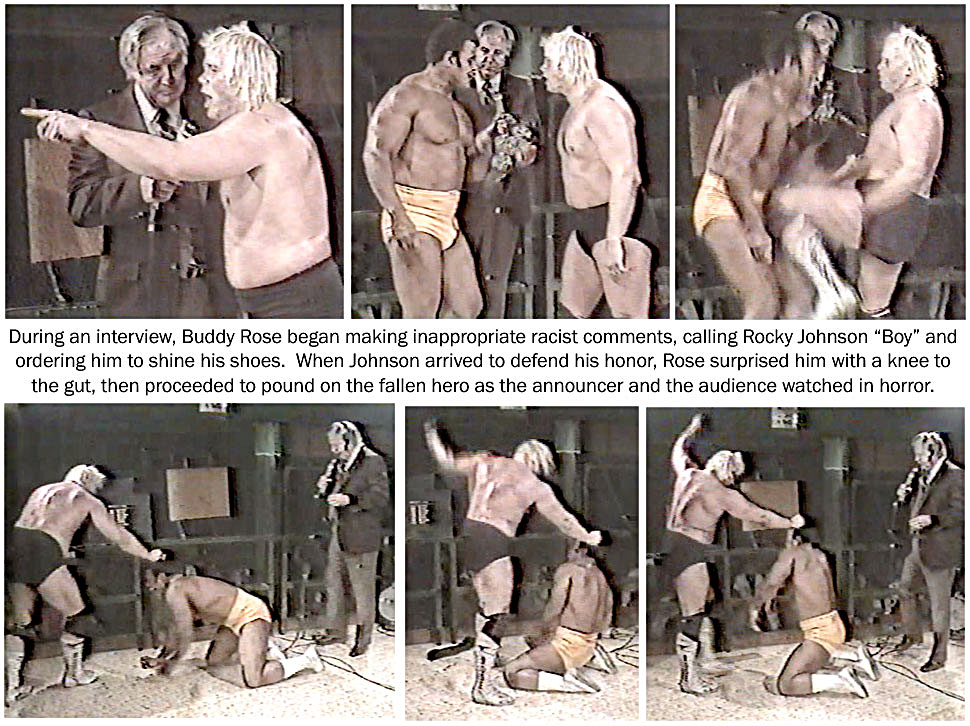
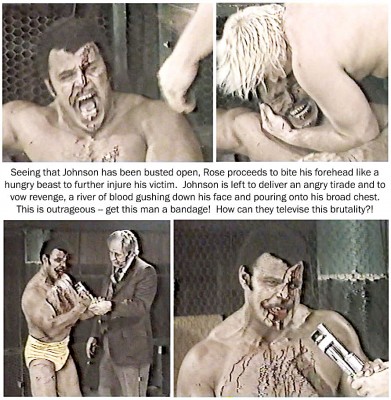

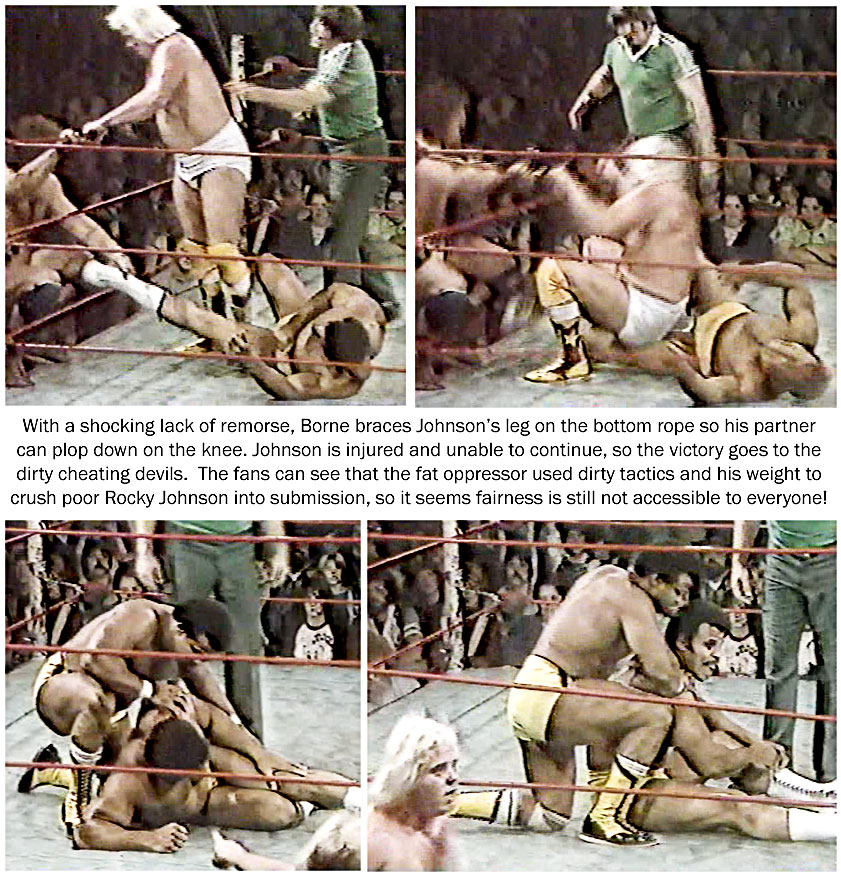
I remember an Iranian (or pretended to be) Heel during the Bush I years and the hostage crisis who would beat the crap out of all-American jobbers. But now everything’s PC. A shame pro wrestling doesn’t “go there” anymore.